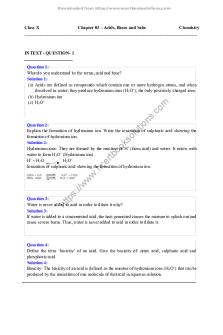Laws of motion - Selina Concise Chemistry Solutions Class 10 Chapter 10 Study of Compounds Nitric PDF

| Title | Laws of motion - Selina Concise Chemistry Solutions Class 10 Chapter 10 Study of Compounds Nitric |
|---|---|
| Author | Simple Creativity |
| Course | Complementary Physics IV (Modern Physics and Electronics ) |
| Institution | Kannur University |
| Pages | 3 |
| File Size | 75.3 KB |
| File Type | |
| Total Downloads | 58 |
| Total Views | 136 |
Summary
Selina Concise Chemistry Solutions Class 10 Chapter 10 Study of Compounds Nitric Acid...
Description
9 ICSE :-
Chapter -3 Laws of Motion (Part-4)
Universal Law of Gravitation According to Newton, the force of attraction acting between two bodies is directly proportional to the product of their masses and inversely proportional to the square of the distance between them. F = Gm1m2/r2 F = force of attraction, r = distance between two masses m 1 and m2 G = universal gravitational constant. Value of G = 6.67 x 10 -11 Nm2/kg2 Unit of G - Nm2/kg2 Gravitational constant G is numerically equal to the magnitude of force of attraction between two masses each of 1 kg placed at a separation of 1 m. Gravitational force between two masses (i) is always attractive. (ii) is directly proportional to the product of the masses. (iii)
is inversely proportional to the square of separation between them. (iv) is significant between heavenly bodies, but is insignificant between ordinary bodies because of small magnitude of G. Importance of the universal law of gravitation By applying this law one can explain the motion of planets around the sun, the motion of the moon (satellite) around the earth and the motion of a freely falling body. Force due to gravity The force with which the earth attracts a body, towards its centre is called force of gravity. F = GMm/R2 The earth attracts a body of mass 1 kg by a force of 9.8 N towards its centre.
1
Acceleration due to gravity (g) The acceleration produced in a freely falling body due to the gravitational force of attraction of earth. Unit is m/s2. Value of g on the surface of earth =9.8 m/s2. It is a vector quantity directed vertically downwards towards the centre of earth. On the Earth’s surface, the value of g varies from place to place. The value of g is zero at the centre of earth. At altitudes above the earth’s surface or at depth below the earth surface, the value of g decreases. On equator, it is slightly less as compared to that at poles. Relationship between g and G g = GM/R2 g = acceleration due to gravity, G = gravitational constant, M = mass of planets or satellites, R = distance between the bodies. The value of g on a planet or satellite depends on the mass and radius of that planet or satellite. Free fall Equations of motions for a freely falling body :- 1.When a body is freely falling from a height v = u + gt h = ut + 1/2gt2 v2 = u2 + 2gh h = height through which the body falls, u = initial velocity, v = final velocity 2.When a body is thrown vertically upwards (g = negative) v = u - gt h = ut - 1/2gt2 v2 = u2- 2gh 3.When a body reaches the highest point then v = 0 u = gt u2 = 2gh hmax = u2/ 2gh Difference 2
between Mass and Weight. Mass
Weight
1.It is the measure of the quantity of matter contained in the body.
1.It is the force with which a body is attracted towards the centre of Earth.
2.Scalar quantity.
2. Vector quantity.
3.S.I unit is kg.
3. S.I unit is newton (N).
4.Measured using physical balance.
4. Measured using spring balance.
5.Variable quantity, varies 5.It is constant for a from place to place due to body and does not change in the value of g. change with the change in place. Gravitational units of Force 1.One kilogram force –1 kgf is the force due to gravity on a mass of 1 kg. 1 kgf = 9.8 N 2 . One gram force – 1 gf is the force due to gravity on a mass of 1 g. 1 gf = 980 dyne. ****************************
3...
Similar Free PDFs

Chapter 10 - notes of class
- 12 Pages

Newton\'s laws of motion-phys101
- 10 Pages

Newtons 3 Laws of Motion
- 10 Pages
Popular Institutions
- Tinajero National High School - Annex
- Politeknik Caltex Riau
- Yokohama City University
- SGT University
- University of Al-Qadisiyah
- Divine Word College of Vigan
- Techniek College Rotterdam
- Universidade de Santiago
- Universiti Teknologi MARA Cawangan Johor Kampus Pasir Gudang
- Poltekkes Kemenkes Yogyakarta
- Baguio City National High School
- Colegio san marcos
- preparatoria uno
- Centro de Bachillerato Tecnológico Industrial y de Servicios No. 107
- Dalian Maritime University
- Quang Trung Secondary School
- Colegio Tecnológico en Informática
- Corporación Regional de Educación Superior
- Grupo CEDVA
- Dar Al Uloom University
- Centro de Estudios Preuniversitarios de la Universidad Nacional de Ingeniería
- 上智大学
- Aakash International School, Nuna Majara
- San Felipe Neri Catholic School
- Kang Chiao International School - New Taipei City
- Misamis Occidental National High School
- Institución Educativa Escuela Normal Juan Ladrilleros
- Kolehiyo ng Pantukan
- Batanes State College
- Instituto Continental
- Sekolah Menengah Kejuruan Kesehatan Kaltara (Tarakan)
- Colegio de La Inmaculada Concepcion - Cebu












